Over the years, guitar manufacturers have become much wiser when it comes to little tricks and tactics that can be used to get a better result, which is important because guitar players all over the world use their instruments in a variety of different contexts, some more conducive to damage than others.
After a few years go by, there can be common complaints about a particular instrument. Guitar-makers hear these complaints and come up with a solution, notably, the volute, so what is it exactly?
Its relevance is particularly pronounced in guitars with tilted headstocks, which inherently have a weak spot at the scarf joint—the area where the headstock and fretboard converge.
A volute (carved heel) is a triangular, reinforced, wooden block added to where the neck and headstock of a guitar meet. Its importance is particularly pronounced on tilted headstock guitars which inherently have a weak spot at the scarf joint – the area where the headstock and fretboard converge.
When explaining a volute, it’s most common for people to use Gibson Les Pauls as an example. We’ll explore volutes, Gibson Les Pauls, and why they’re relevant when addressing volutes, as well as the history of the volute and why guitar manufacturers started to use them. Additionally, it’s important to understand that not every guitar even needs one, to begin with.
What is a Volute and Why They’re Used
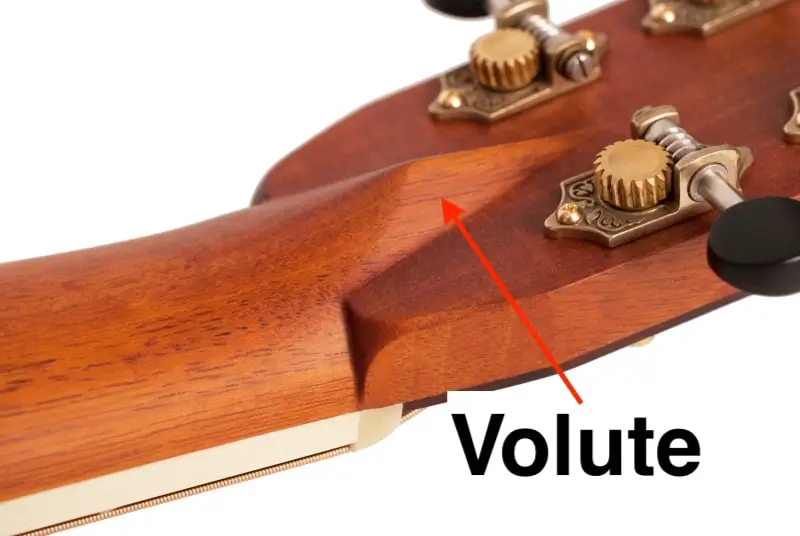
As it was just noted, a volute is a small piece of wood that’s placed where the neck and the headstock begin, and the whole purpose of it is to increase the strength and durability of the instrument.
The purpose of this is that it won’t break easily after having been dropped or exposed to some other kind of potentially damaging force.
Typically, Gibson Les Pauls and other similar instruments have a one-piece neck which means it has been crafted in such a way that it’s all together, as one piece, but the headstock is on somewhat of an angle in relation to the neck.
A volute is when the manufacturer beefs up the point where the headstock and the neck begin by adding just a bit more wood there.
It has been commonly stated among guitar players and others that volutes were developed in response to the weakness of Gibson Les Paul’s guitar necks.
The Gibson Les Paul is one of the first guitars ever to be mass-produced, and while they have a legendary reputation even to this day, players noticed they had a particular vulnerability about them.
That vulnerability has to do with the angle of the Gibson Les Paul’s neck, and how it was so susceptible to breaking if it ever was dropped.
If you take a look at a Fender Stratocaster or a Fender Telecaster, for example, they have straight head-stocks, which means they’re less likely to break after having been dropped.
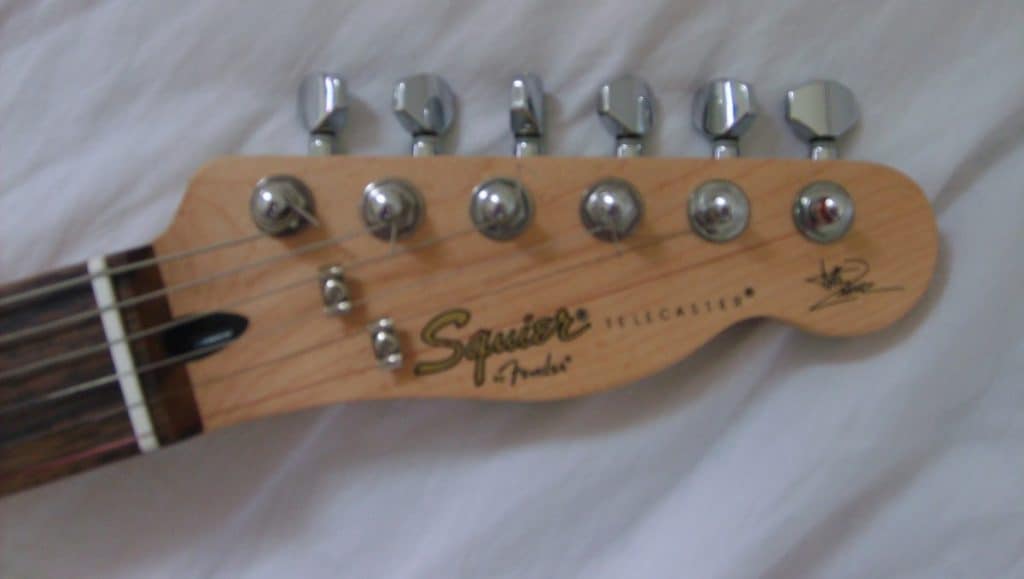
It’s not hard to understand why, and it can be demonstrated by placing a Gibson Les Paul flat on a table next to a Fender Stratocaster. The Gibson Les Paul’s headstock will touch the table.
In fact, there will be a lot of pressure on the headstock as well which increases the load on the weakest point of the instrument, which is where the neck and the headstock combine.
The Fender Stratocaster, on the other hand, won’t lie on the table in the same way because it doesn’t have an angled headstock.
This particular instrument will lay flat on the table with the body holding most of the weight, and there won’t be any pressure on the neck at all, simply because the neck is straight.
This is why you’ll never see a Fender Strat or a Telecaster with a volute, it’s simply not needed.
Gibson Les Paul headstocks, on the other hand, are always constructed on somewhat of an angle, and this is why the instruments tend to break in this area, which has become a commonly repeated trope at this point.
In fact, before I knew this about Gibson Les Pauls, I remember going into a guitar shop and there was a Les Paul Standard on sale that a guy working there had recommended to me.
He told me it snapped at the headstock and the neck, and I never thought anything of it at the time, except for not being interested in it at all. Who wants to buy an instrument that is practically split in half?
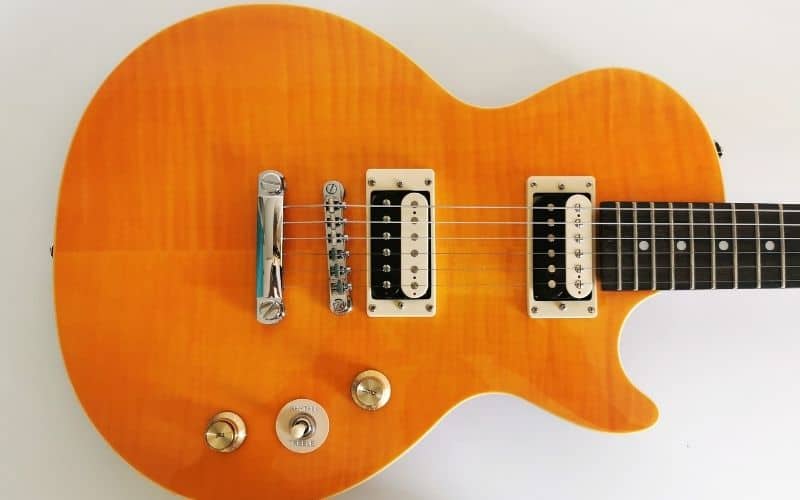
Only later did I figure out that this is actually a ubiquitous problem for Gibson Les Pauls and Gibson SGs as well, because both of these instruments have an angled headstock in relation to their neck, contrasted to the Fender Tele and the Strat.
Guitar Neck Volute – The Solution to the Neck Weakness
From what I understand, even though the volute is known for being a good solution to this problem, Gibson has never made this a standard in their instruments.
I’m not sure why, but I’m sure there is a reason for not using the volute as a means for reinforcing the weak point of the Les Paul guitar neck.
It seems like other guitar manufacturers have adopted the volute, for example, my ESP Eclipse II has a volute on the headstock and it can be clearly seen in the image below:
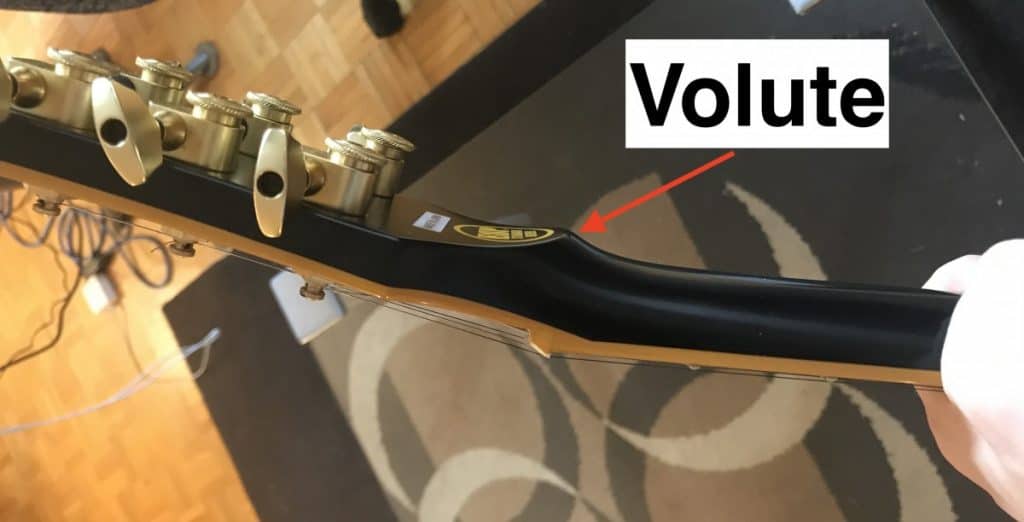
There are a lot of questions about why things are done the way they are, especially posed by people who are outside of the community.
For example, some wonder why the guitar headstock needs to even be on an angle, to begin with. Why not just use a straight neck the way that Fender does with their instruments?
Why Are Some Guitar Headstocks On An Angle?
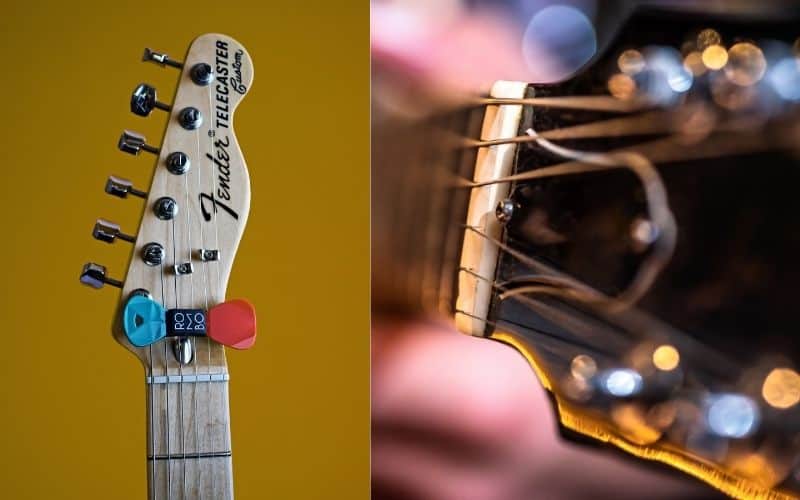
Guitar necks and headstocks are on an angle because, in order for the strings to fit properly in the slots of the nut, the guitar strings have to be folded over a “break-point” – which is at an angle.
Some guitar manufacturers do this in different ways, for example, Fender does it with their string-tree method, whereas Gibson just angles the headstock.
Angling the headstock works just fine, however, it introduces problems like what I’ve already explained above, (the fact that Gibson Les Paul headstocks are known for breaking).
According to Haze Guitars, Gibson Les Paul’s necks are often crafted out of just one piece of timber, and this has been marketed as being great for the tone and resonance because it facilitates the sound vibration through one piece of wood.
There is no break-point with two pieces of wood attached together, which, in theory, would disrupt the flow of vibrations.
The problem with this one-piece neck, however, is that the neck tends to break where the neck and the headstock join, leading to the commonly stated problem of Gibson Les Paul necks breaking.
Why Don’t Gibson and Other Companies Just Use A Volute?
As I said above, My ESP Eclipse II has a volute on it, whereas my Epiphone Les Paul Custom (a Gibson subsidiary) does not.
Fans of Gibson – which is easily one of the most iconic, biggest, and most legendary brands – don’t like to see a lot of changes to the company’s instruments.
Gibson fans don’t want to see any sudden changes to the necks or any parts of the guitar, so instead, they go about making instruments the way that they always have to please their more conservative fans.
As I said above, a lot of people claim the one-piece neck is better for tone as well, so that’s worth mentioning.
Other Articles You May Be Interested In
- How to Set Up An ESP Eclipse [A Step-By-Step Guide]
- Are Guitar Necks Supposed To Be Straight?
- What Is A Warped Guitar Neck?

YouTube Video Tutorial
Conclusion
I hope this explanation was useful to you. Essentially, a volute is just a wooden reinforcement that’s added to an angled guitar neck, as a way of increasing its strength and durability.
If you think about it, it makes a lot of sense. What’s being done is that there is just more wood at the weak point, which means it’s a little stronger and a little more resistant to breaking.

 Written By :
Written By :
